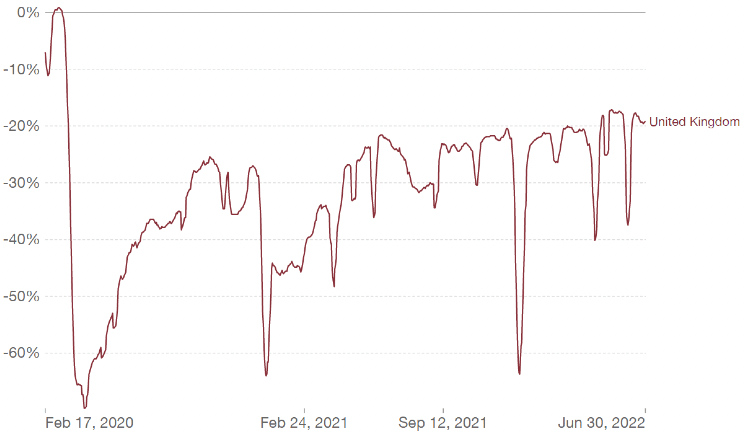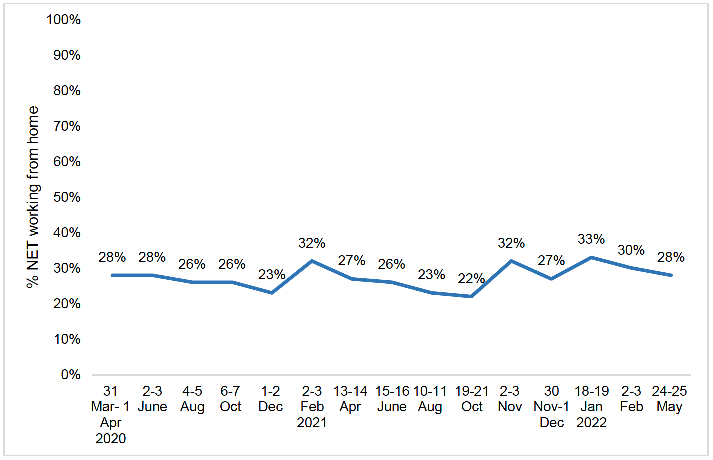Working from home during the COVID-19 pandemic: benefits, challenges and considerations for future ways of working
To understand in the short-term how employees may respond to a policy, such as working from home, this report draws on a rapid review of relevant literature (from 2020-2022) and responses from an open-ended survey with members of the public in Scotland.
Introduction
Before the pandemic in 2019, there was an estimated 1.7 million people in the UK who said that they work mainly from home. This represented just over 5% of the total workforce.[1] However, opportunities for working from home varied by professional sector. For example, the information and communication sector and professional and scientific sector provided more opportunities for people to work from home than sectors such as transport, hospitality and retail.[2]
In 2020, in order to minimize the risk of spreading the virus, governments required people to work from home, unless they were key workers.[3] However, an important difference between earlier home working and working from home during the pandemic was the fact that, for affected sectors, it was sudden, unplanned and mandatory. This represented a major change for a large number of people.
To understand in the short-term how workers may respond to a new policy, such as working from home, this report draws on a rapid review of relevant literature (from 2020-2022) and responses from an open-ended survey with members of the public in Scotland. This evidence was synthesised and then presented across two main sections, which are: the potential benefits and challenges of working from home during the pandemic.
Hybrid working (a type of working where an employee splits their time between the workplace and remote working) has now been embraced by a number of organisations across the UK. The Scottish Government encourages employers to facilitate hybrid and flexible working, where it is possible and appropriate, and has developed guidance for businesses and workplaces. Therefore, this work will be used to help inform Scottish Government policy colleagues who are currently developing work exploring the impacts, challenges and opportunities of hybrid working for the wider economy.
Definitions
The term 'working from home' does not have a single definition and it can be used in various ways. For the purpose of this report, it is used to refer to a situation where an employee performs their work tasks remotely, using information and communication technology (such as a laptop) in a location which is not their default place of work. In most cases, this includes work performed in the home so there is no commute. However, some people may work from another location such as a family member's home.
Hybrid working refers to type of flexible working where the employee splits their time between their workplace (such as an office) and their home.[4] [5]
What happened?
COVID-19 reshaped the way we live and work. It normalised remote working which led to new and enduring trends in work and worker behaviour, and the economies around them.
In Scotland, the first day of 'lockdown' was on March 24th 2020. People were required to stay at home and only travel to and from work that was deemed to be essential. Employers were requested to make provisions so that people could work from home in Scotland.[6]
As to be expected, in April 2020, there was a large decline in visits to workplaces in the UK, falling by about 70% below pre-pandemic levels.[7] As detailed in Figure 1, visits to workplaces were at their lowest in December 2020 (down by 64%) and December 2022 (down 63%), coinciding with periods of tighter restrictions and high numbers of daily COVID-19 cases.[8]

At the beginning of the pandemic, on 31st March- 2nd April 2020, 28% of those not retired were working from home (Figure 2).[10] As detailed in the timeline in Annex C, public health restrictions during 2020 to 2022 impacted on people's ability to work from home or a workplace. For example, from 31 January 2022 – following the vaccination programme and a decreased level of threat from COVID – compared to earlier stages of the pandemic, businesses were advised to prepare for a new situation of hybrid working where possible and appropriate and figures have seen a slight decrease since then.

Source: YouGov Scotland Survey: Base: Adults not retired (n=697-747)
The purpose of this report
This report draws on a range of evidence from surveys, mobility data and qualitative research, to summarise the effects of this change, explore people's working patterns, perceptions and experiences and then set out the advantages and disadvantages of working from home.
Surveys document the proportion of people who are working from home or working from a workplace such as an office. Different surveys record changes over time and note differences by profession, income and other demographic characteristics such as age, gender and ethnicity. Survey research also captures levels of loneliness, levels of social contact and employee satisfaction to understand the impact of working from home on topics such as, wellbeing, social isolation and productivity.
Mobility data (gathered when people interact with Wi-Fi, Bluetooth or tagging locations on social media) describes people's movements over time and in different categories of places such as retail, hospitality, parks and workplaces. The data does not provide a direct measure of people's behaviour but it can provide a general impression of how people are moving about a region.
Qualitative research usually involves collecting first-hand accounts to understand opinions or experiences. Using approaches such as interviews or an open text format can provide a more in-depth insight into people's views. This approach helps to gather understanding into whypeople may feel a certain way and it offers people the chance to describe their experiences in their own words.[12]
Methods
To understand in greater detail what people's experiences and perceptions were of working from home during the pandemic, two main approaches were used (for more information see Annex A and Annex B):
- A rapid evidence review: A targeted literature search to identify academic literature and 'grey literature' (for example, materials and reports that are not produced by commercial publishers).
- Free-text survey: an online survey was conducted that included open text sections for people to describe their experiences in their own words (see Annex A). Respondents were asked a range of questions about how they currently felt and their views towards the different COVID-19 protection measures, which included working from home. 3162 people completed the survey, of which, the majority (70%) were women. 60% were employed and 8.5% were self-employed. Approximately, a third of respondents provided comments on working from home.
Analysis
The findings from the free-text survey and the literature review (51 articles, reports, books) were combined and presented together within this report. This involved a team of social researchers reading the literature and survey responses in order to identify patterns and initial codes. Preliminary themes were then identified, reviewed and finalised.
In terms of the free-text survey, research questions about working from home were answered during the Omicron wave of infections (January/February 2022) when Scotland recorded a record high number of cases. For some people, this may have been an anxious and uncertain time and interpretation of the findings should take this into account. This research was also done before most employees had any experience of hybrid working. For a more detailed note on the timing of the research and the implications this may have had on people's perceptions of the benefits and challenges, see Annex B.
Quotes from different respondents were used to illustrate these themes. The quotes that are provided through the report are intended to capture some of the points being made in respondents' own language and terminology. These were selected by the authors for illustrative purposes. Therefore, quotes are not necessarily representative of other respondents' views. The sample was self-selecting and therefore not representative of the wider Scottish population. It is also likely that particular groups did not participate in the survey, for example more disadvantaged groups, meaning their perspectives were not included.
Structure of the report
This report is structured into two sections:
1. The benefits of working from home
2. The challenges of working from home
See Annex A and Annex B for more details on the methods used to gather and analyse the data, limitations and a full list of all the evidence used in this report.
Contact
Email: socialresearch@gov.scot
There is a problem
Thanks for your feedback